

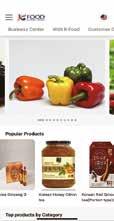






%
of annual carbon emissions come from the food sector!
Let’s work together to minimize carbon emissions at all stages of food system
Increase production of Eco-friendly agricultural and marine products
Reduce distribution steps and use green fuels
Prepare only the necessary amount of food and consume it without any leftover
Minimize waste in processing and handling
As a response to climate change, we support the declaration of a Global Low Carbon Diet Day to reduce carbon emissions from food, which accounts for 31% of global greenhouse gas emissions, and the formation of the Low Carbon Diet Forum, a movement for action that promises a healthy humanity, a healthy planet, and a sustainable future.
One. We recognize that a low carbon diet is essential for a healthy global environment, which is directly related to the future of humanity.
One. We will solidarise and cooperate in all projects and activities promoted by the international community to achieve food carbon neutrality.
One. We will work together to minimize carbon emissions at all stages of food production and consumption.
One. We will designate every Wednesday as Low Carbon Diet Day to promote and practice the importance of food carbon neutrality.
As a public institution in charge of food industry, aT has established a network of cooperation with more than 600 companies, institutions, and organizations at home and abroad to spread low-carbon diet movement.
Please scan the QR below, and show your support



Innovating Convenience with Self-Heating Meal Solutions
Farming Association Corporation: Pioneering the Chestnut Processing Industry with Premium Korean Chestnuts



ALTist’s Premium Plant-Based Portfolio:
Setting New Standards for Taste and Texture
Fresh Fruit Trading Hubs: Wholesale Markets in Korea

Korean Korean Cheese Cheese Trends Trends




Korean Frozen Dumplings: A Hit on Japan's Rakuten



Promoting Korean Agricultural Products in Conjunction with the 2024 Paris Summer Olympics Kimchijeongol
Korean
A Convenient Way to Enjoy a Variety of Dishes BokManSa Co., Ltd.: The First to Develop Frozen Gimbap Made from Korean Rice
Frozen Food Market Size and Trends 2022
This issue’s cover story, “K-Diet Foods,” highlights the emerging trend of healthy, low-calorie ingredients like konjac and glass noodles as alternatives to flour-based products. Enjoy a convenient, stress-reducing diet with options such as chicken breast bars, fried rice, and konjac tteokbokki. An interview with Bionulab, a leading dietary solution company in Korea, will provide insights into a substance that helps reduce body fat while simultaneously strengthening muscles. Explore the stories of “Sunny Day,” a company that exports freeze-dried kimchi seasoning blocks, and “Dalbodre,” a peach farm renowned for its hard peaches that sell out in August. Furthermore, this issue covers Devotionfoods, a company producing plantbased meat alternatives that are over 90% similar to real meat, the premiumization of Korea’s pet food market, and a recipe for hwachae (fruit punch), a popular summer treat. The photo essay showcases the versatility of corn as an ingredient in bread, noodles, and rice cakes. Lastly, we examine the popularity of konjac jelly on Vietnam’s leading online shopping platform, Shopee, where it is currently featured as a diet food of the month.
Kim, Eil Chul Chief Reporter
Founded in August, 1995, Published monthly by the
227, Munhwa-ro, Naju City, South Jeolla Province, Korea Tel: +82-61-931-0963 Fax: +82-61-804-4521
Government Registration Number: Ra-7210
Dated April 26, 1995
Copyright by the aT (Korea Agro-Fisheries & Food Trade Corp.) All rights reserved.
CEO Hong Moon-pyo
EXECUTIVE VICE PRESIDENT Kwon O-yub (Food Industry & Trade Division)
EDITOR Hwang Doyoun
CHEIF REPORTER Kim Eil Chul
COORDINATOR Yoon Hyun-joo
CREATIVE DIRECTOR Chang Soobum
PHOTOGRAPHY DIRECTOR Hwang Donggun
TRANSLATORS Kivit Adrianus (ENGLISH), Shin Nakajima (JAPANESE), Bart Wu (CHINESE)
EDITORIAL BOARD
BEIJING John Dae-young (redsun@at.or.kr) 070-4617-5090
SHANGHAI Lee Jong-geun (jglee@at.or.kr) 070-7077-6197
DALIAN Lee Jeong-seok (rhee@at.or.kr) 070-4617-3278
HONGKONG Kim Hyun-hoo (max@at.or.kr) 070-4617-2696
QINGDAO Lee Sun-Woo (bird@at.or.kr) +86-532-5566-8873
QINGDAO aT LOGISTICS Han Seung-hee (shhan@at.or.kr) 070-7939-0863
HANOI Kim Kyoung-chul (yohang@at.or.kr) +84-24-6282-2987
HOCHIMIN Cho Sung-bae (chobae@at.or.kr) 070-8098-6514
BANGKOK Byun Kyung-yong (yong7619@at.or.kr) 070-4617-7227
JAKARTA Lee Seung-hoon (afmchoon@at.or.kr) +62-21-2995-9094
KUALALUMPUR Jang Jung-ho (lastjang@at.or.kr) 070-5223-4901
TOKYO Yoon Sang-young (foodkorea@at.or.kr) +81-3-5367-6656
OSAKA Kwon Hyun-ju (hyunjukun@at.or.kr) 070-7000-4138
NEW YORK Shim Hwa-Sop (sirshim@at.or.kr) +1-212-889-2561
LA Kim Min-Ho (mhkim@at.or.kr) +1-562-809-8810
SAO PAULO Jung You-sun (usuni@at.or.kr) +55-11-3283-0089
DUBAI Jeon Yong-pil (pioneer@at.or.kr) +971-4339-2213
PARIS Nam Sang-hui (mudpearl@at.or.kr) +33-1-4108-6095
MOSCOW Shin Jae-hun (chekov@at.or.kr) 070-4617-3277


The export and domestic consumption of Korean frozen foods have experienced rapid growth, driven by several factors. Technological advancements in rapid freezing and the establishment of a systematic cold chain have facilitated the stable supply of premium frozen foods. The growing popularity of air fryers has made it easier to achieve flavors that were previously challenging to reproduce using a microwave. Furthermore, the global dissemination of Korean cultural content and the surge in demand for convenient frozen foods due to the impact of COVID-19 have played an important role in this trend. The ongoing growth of the diverse home meal replacement (HMR) frozen food market has further contributed to this increase. Finally, the distinctive benefits of frozen foods, the cultural nuances of Korean cuisine, and the introduction of innovative frozen food products aligned with consumer preferences have collectively contributed to this growth trajectory.
Ms. P, a homemaker and businesswoman with 13 years of experience, is a regular consumer of frozen foods, purchasing them at least once or twice a week. She values the convenience of cooking and enjoying meals immediately, with the option to store leftovers in the freezer. However, a few years ago, she was initially reluctant to cook with frozen products, concerned about their quality and healthiness. The emergence of specialized frozen food companies like CJ CheilJedang and BokManSa Co., Ltd., known for their premium offerings, along with reliable food safety systems
such as HACCP, have transformed her perception. She now confidently selects frozen foods without hesitation, reassured by their quality and safety.
Ms. P uses the air fryer to prepare frozen chicken, pizza, and dumplings in under 10 minutes with minimal effort. The innovative circulation system of the latest air fryers guarantees that food items are cooked to perfection, with a crispy exterior and a tender interior. Frozen pizza offers a taste that is comparable to that of freshly baked, while frozen dumplings can be enjoyed as crispy delights. An air fryer can be used to prepare a variety of frozen foods, including dumplings, chicken dishes, soups, and stews. Frozen gimbap can also be quickly prepared in the microwave. Convenience stores in Korea offer a wide range of frozen foods. Online and offline services like Market Kurly’s overnight delivery and Baemin’s 30-minute delivery have made purchasing frozen foods convenient.
The primary frozen foods in the domestic market include CJ CheilJedang’s “Bibigo Mandu” (dumplings), Ottogi’s “Oz Chicken Cheese Sticks” (fried food), Pulmuone’s “ORGA Neobiani” (Korean side dishes), Ottogi’s “Oz Chicken Teppan Gamjatang Fried Rice” (frozen rice), Daesang’s “Bulgogi Chicago Pizza” (pizza) of Zipeuro ON, Pulmuone’s “Block Cheese Tonkatsu” (cutlets), Daesang’s “Mozzarella Hotdog” (hotdog), Pulmuone’s “Secret Bakery Roasted Sweet Potato Bread” (bakery), and BokNanSa’s “Vegan Gimbap” (frozen gimbap). These products represent the leading offerings from their respective companies.
様々な料理を手軽に楽しめる韓国の冷凍食品
最近、韓国の冷凍食品の輸出と国内外での消費 が急増している。その理由として、1つ目に韓国の 急速冷凍技術の発展とシステムの体系化によるプ レミアム冷凍食品の安定した供給が挙げられる。
2つ目に、電子レンジだけでは再現が難しかった 冷凍食品の味が、エアフライヤーの普及によって
簡単に再現できるようになった。3つ目に、韓国の 文化コンテンツが世界に広がり、新型コロナウイ ルス感染症により手軽な冷凍食品の需要が増加 して、多様なHMR冷凍食品市場が拡大している。
4つ目に、冷凍食品特有の長所を生かし、韓国料 理の文化的特性、消費者のニーズに合わせた新し い冷凍商品の開発が続いている。
13年間、主婦兼事業家として働いてきたPさんは、 毎週1~2回以上冷凍食品を購入している。彼女 は冷凍食品の購入理由として、いつでもすぐに食
べることができ、残った分は再び冷凍庫に保管で きる点を挙げている。そんな彼女も、数年前まで は冷凍食品を使って料理することをためらってい た。安いけど美味しくない上、健康にも良くなさそ うだという懸念を払拭できなかったからである。
しかし、冷凍餃子のCJ第一製糖、冷凍キンパブの

「福を作る人たち㈱」など冷凍食品専門企業の 登場や多彩なプレミアム製品の発売、HACCPなど 食品衛生安全システムへの信頼などによって、今 は躊躇うことなく冷凍食品を選択している。
Pさんはエアフライヤーを使って冷凍鶏肉製品や 冷凍ピザ、冷凍餃子などを、約10分という短時間 でいくらでも調理することができる。最近のエア フライヤーは熱風の循環性能が優秀で、特有の表 はサクサク、中身はしっとりとした美味しい料理 を作ることができる。冷凍ピザはまるで焼きたて
のピザのように、冷凍餃子は焼き餃子のように楽 しむことができる。冷凍餃子や冷凍鶏肉料理、冷 凍鍋や冷凍チゲなどはエアフライヤーで、冷凍キ ンパブは電子レンジで簡単に調理できる。近所の コンビニでもかなりの冷凍食品を販売している。
Market Kurlyの夜明け配送、30分ほどで配達さ れる「配達の民族」など、必要な冷凍食品はオン ラインでもオフラインでも簡単に購入できる。 韓国の主な冷凍食品には、CJ第一製糖の「ビビゴ 特大餃子(餃子類)」、オットギの「オズチキンチー
ズスティック」(揚げ物類)、プルムウォンの「ORGA 宮中焼き肉」(韓食のおかず)、オットギの「オズチ キン鉄板カムジャタンチャーハン」(冷凍ご飯)、大 象「家へON」の「焼肉シカゴピザ」(ピザ)、プルム ウォンの「ブロックチーズトンカツ」(カツ類)、大象 「家へON」の「モッツァレラホットドッグ」(ホット ドッグ)、プルムウォンの「秘密パン屋焼き芋パン」 (ベーカリー)、「福を作る人たち」の「ビーガンキン パブ」(冷凍キンパブ)などがあり、これらが主要企 業の代表的な冷凍食品といえる。
BokManSa Co., Ltd. has made history as the first company in South Korea to commercialize frozen gimbap, creating a groundbreaking product with a shelf life of up to 12 months—significantly longer than the traditional refrigerated gimbap, which could only last for three days. In addition, the company has developed a specialized container that evenly heats the gimbap in under three minutes, ensuring quick preparation. By leveraging the phenomenon of resistant starch, which occurs during the freezing process of rice, BokManSa has developed a low-calorie version of frozen gimbap. This involves reducing the starch from grains and incorporating plant-based proteins to create a low-sugar frozen gimbap product. This innovative process reduces the starch content while incorporating plant-based proteins, resulting in low-sugar frozen gimbap options. Typically, gimbap is composed of rice and a variety of fillings in equal proportions. Over the past year, BokManSa has produced 5 million gimbap, using over 600 tons of domestically sourced agricultural, fishery, and livestock products. This includes approximately 300 tons of rice and 300 tons of ingredients such as carrots, beef, fish cakes, and seaweed. With each gimbap roll measuring 23 cm, the total length of all rolls is 1,150 km.
BokManSa offers a diverse range of frozen gimbap, including “regular gimbap,” “protein gimbap,” “vegan gimbap,” “ketogenic gimbap,” “halal/kosher certified gimbap,” and “carbohydrate-restricted gimbap.” The general gimbap is the closest product to the original form of gimbap, and it is suitable for everyone. The
韓国初の開発、「福を作る人たち㈱」
「福を作る人たち㈱」は韓国で初めて冷凍キンパブを商 品化した。製品の流通期限が3日間だった従来の冷蔵キ ンパブに比べ、12か月間保存できる画期的な製品を作っ たのである。また、3分以内にムラなく温めることができ る容器を開発し、3分調理が可能な冷凍キンパブとなって いる。米を冷凍する過程で発生するレジスタントスターチ 現象に着目し、低カロリーの冷凍キンパブ製造方法を開 発し、また穀類のでんぷんを減らし植物性たんぱく質な どを活用して低糖冷凍キンパブも作っている。一般的な キンパブには、米と材料が半分ずつ使われる。「福を作 る人たち㈱」は、昨年一年間に約600トンの韓国産農水 畜産物を使い500万本のキンパブを作った。韓国産米約 300トンと人参、牛肉、かまぼこ、海苔など300トンの食 材が使われた。キンパブ1本の長さは23cmなので全長 1,150kmに達する。
「福を作る人たち㈱」の冷凍キンパブには、<一般キンパ ブ>以外にも<たんぱく質キンパブ><ヴィーガンキンパ ブ><ケトジェニックキンパブ><ハラル/コーシャキンパ ブ><糖質制限食キンパブ>などがある。<一般キンパ ブ>は、誰でも楽しめるキンパブの原型に近い製品であ る。<たんぱく質キンパブ>は低炭水化物・高たんぱくの 食事を必要とする消費者向けのキンパブである。<ヴィー ガンキンパブ>は健康な5種の雑穀と植物性材料で作ら れ、<ケトジェニックキンパブ>は低炭水化物・高脂肪の
protein gimbap is designed for customers seeking low-carb, high-protein options, while the vegan gimbap is made with wholesome grains and plant-based ingredients. The ketogenic gimbap is crafted using plant-based meat and is low-carb and high-fat, making it an ideal product for those following a keto diet. Halal and Kosher-certified gimbap are produced in accordance with the strict dietary laws of the Islamic and Jewish faiths. BokManSa has developed over 100 varieties of gimbap through partnerships, including unique offerings such as cabbage egg konjac gimbap, 11:45 vegan gimbap, plant-based bulgogi & spicy pepper gimbap, and plant-based tuna gimbap.
In 2021, BokManSa received international vegan certification for ten frozen gimbap items, including “vegan gochujang bibimbap kimbap” and “vegan japchae gimbap.”
In 2022, they achieved FSC22000 food safety certification for gimbap, cheese sticks, and tart production. They also received ISO 22000 food management safety certification in 2021. In 2023, the company received HALAL certification, and in 2024, it received KOSHER certification. BokManSa has consistently expanded its export markets, achieving USD 472,000 in exports to seven countries in 2021. These included USD 397,000 to Hong Kong, USD 29,000 to the United States, and USD 28,000 to Japan. In 2022, exports increased to USD 502,000 across ten countries, with key markets including USD 263,000 to Hong Kong, USD 65,000 to Taiwan, and USD 59,000 to France. In 2023, the company reached a total of USD 1.07 million in exports to 19 countries, including USD 765,000 to the United States, USD 54,000 to the United Kingdom, and USD 51,000 to Canada.
食品で、植物性の肉が使われる。<ハラル/コーシャキン パブ>はイスラムとユダヤ教の戒律に合わせて作られる ている。<糖質制限食キンパブ>は、献立の調整が必要 な患者向けの簡便食キンパブである。<キャベツ卵コンニ ャクキンパブ><11時45分ヴィーガンキンパブ><植物 性焼肉&テンチョ(激辛唐辛子)キンパブ><植物性ツナ キンパブ>など、取引先とのコラボで生産した製品を含 め100種余りに上る。
2021年の「ヴィーガン唐辛子ビビンバキンパブ」「ヴィー ガンチャプチェキンパブ」など5品目に、新しく2022年に は「唐辛子豆腐野菜ヴィーガンキンパブ」など5つの品 目を追加して、10種の冷凍キンパブ品目について国際ヴ ィーガン認証を獲得した。2022年にはキンパブ、チーズス ティック、タルトの製造に関する食品安全システム認証 (FSC22000)を、2021年には食品マネジメント安全システ ム認証(ISO 22000)を、2023年にはハラル(HALAL)認証を、 2024年にはコーシャ(KOSHER)認証を獲得した。2021年 には香港39万7千ドル、米国2万9千ドル、日本2万8千ドル など、7か国へ47万2千ドルを輸出した。2022年の輸出額 は、香港26万3千ドル、台湾6万5千ドル、フランス5万9千 ドルなど10か国を対象に50万2千ドルを記録した。2023 年には米国76万5千ドル、イギリス5万4千ドル、カナダ5万 1千ドルなど19か国へ100万7千ドルを輸出した。
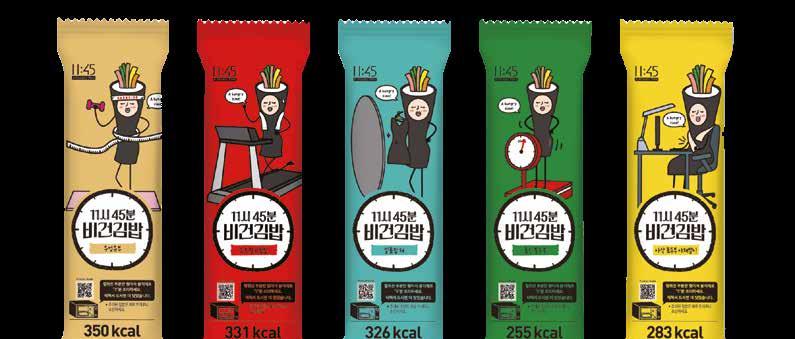
CEO: Cho Eun-woo
E-MAIL: hdsfood@daum.net, 11.45@daum.net
WEBSITE: www.bokmansa.kr
TEL: +82-55-884-2252
ADDRESS: 2498-11, Seomjingang-daero, Hado-eup, Hadonggun, Gyeongsangnam-do, 52322, Republic of Korea
BokManSa Co., Ltd. is a pioneering South Korean company that commercialized frozen gimbap, offering a range of innovative products like low-calorie, vegan, ketogenic, and halal/kosher-certified options.
BokManSa Co., Ltd.は、冷凍キンパを商業化した韓国の先駆

In 2022, South Korea’s domestic frozen food production reached KRW 3.4506 trillion, a 13.3% increase from KRW 3.3449 trillion in 2021. The export value of frozen foods also saw a 7.8% increase, reaching KRW 634 billion. However, exports of frozen dumplings declined by 11.6%, reaching a total of KRW 450 billion. In contrast, exports of hot dogs increased by 162.7% to KRW 165 billion, while frozen pizza exports grew by 17.3% to reach KRW 19 billion.
In 2022, the domestic frozen dumpling market was estimated to be KRW 470.3 billion, a decrease of KRW 118.3 billion compared to 2020. CJ CheilJedang held the leading position in the market with a 47.5% share, followed by Haitai Confectionery & Foods at 15.2% and Pulmuone Foods at 12.7%. The product composition of the frozen dumpling market was as follows: gyoza dumplings (45.5%), jumbo-sized dumpling dumplings (25.4%), steamed dumplings (11.3%), and pan-fried dumplings (5.2%). In terms of distribution channels, large retail marts accounted for the largest share (37.3%), followed by chain supermarkets (23.7%), independent supermarkets (22.7%), and convenience stores (7.9%).
In 2022, the frozen ready-meal market was valued at KRW 225.2 billion, with frozen desserts accounting
2022年時点の韓国冷凍食品市場の
規模と動向
2022年時点の韓国冷凍食品の生産規模は3兆4,506億ウォ ンで、2021年の3兆449億ウォンに比べ13.3%増加した。
2022年の冷凍食品の輸出は、対前年比7.8%増加した634 億ウォン規模である。冷凍餃子の輸出額は対前年比11.6% 減少した450億ウォン、ホットドッグの輸出額は対前年比 162.7%増加した165億ウォン、冷凍ピザの輸出額は対前年 比17.3%増加した19億ウォン規模となっている。
2022年の韓国冷凍餃子市場の規模は、2020年に比 べて1,183億ウォン減少した4,703億ウォンに集計され た。冷凍餃子の各メーカー別市場シェアはCJ第一製 糖(47.5%)、ヘテ製菓食品(15.2%)、プルムウォン食品 (12.7%)の順となっている。2022年の各製品の割合は、 一般餃子(45.5%)、特大餃子(25.4%)、水餃子(11.3%)、
for 88.4% and frozen soup dishes for 11.6%. In the domestic frozen dessert market, 52.6% of sales were of side dishes, while 40.0% were of snacks. The top-performing manufacturers in this sector, based on sales figures, were CJ CheilJedang (KRW 58.4 billion), Ottogi (KRW 47.3 billion), Pulmuone Foods (KRW 37.1 billion), and Lotte Wellfood (KRW 6.2 billion). In 2022, the frozen soup dish market was comprised of frozen stews (KRW 15 billion, 57.5%), frozen soups (KRW 10.4 billion, 39.5%), and frozen broths (KRW 800 million, 3.0%).
The leading manufacturers in this category were Daesang (KRW 6.8 billion, 25.9%), Freshji (KRW 3.1 billion, 11.8%), and CJ CheilJedang (KRW 1.6 billion, 6.2%).
The average consumer in South Korea purchased frozen foods approximately three times a month in 2022. Frozen dumplings, frozen pork cutlets, frozen soups/stews, frozen cakes and bakery items, and frozen porridge or rice were purchased at a rate of twice a month. The average consumption frequency of frozen foods was approximately twice per week, with a higher rate observed among male consumers than female consumers. Frozen foods were consumed primarily on weekdays (81.2%), with dinner accounting for 58.8% of consumption, followed by snacks (40.6%) and lunch (31.2%). The most frequently purchased frozen product was frozen dumplings (56.4%), followed by frozen pizza, pork cutlets, and patties. Consumers cited “ease of preparation” and “taste” as the primary reasons for purchasing frozen foods.
In 2022, 64.6% of frozen food purchases were made offline, while 35.4% were made online. The majority of offline purchases were made at large supermarkets (36.6%), followed by small neighborhood supermarkets (7.4%), SSM-type supermarkets (7.4%), warehouse stores (5.6%), food ingredient marts (5.2%), and convenience stores (1.2%). Online purchases were made through online shopping malls (10.4%), large mart online malls (9.8%), social commerce platforms (7.4%), fresh food delivery services (6.2%), and home shopping (1.2%). Overall, consumer satisfaction with frozen foods available in the market averaged 3.8 out of 5 points, with 75.2% of consumers expressing satisfaction. Among the various product categories, frozen dumplings received the highest average rating of 4.1 points, with 84.6% of respondents indicating satisfaction.
焼き餃子(5.2%)の順である。2022年時点の冷凍餃子の 流通チャネルは、大型総合スーパー(37.3%)、チェーンス ーパー(23.7%)、独立スーパー(22.7%)、コンビニ(7.9%) の順である。
冷凍簡便食の市場規模は2022年に2,252億ウォンとなり、 冷凍デザート類が88.4%、冷凍汁物料理が11.6%を占め ている。2022年の韓国の冷凍デザート類市場では、おか ず用が52.6%、おやつ用が40.0%を占めている。2022年 の韓国冷凍デザート類のメーカー別売上高はCJ第一製糖 が584億ウォン、オトゥギが473億ウォン、プルムウォン食 品が371億ウォン、ロッテウェルフードが62億ウォンであ る。2022年時点における韓国の「冷凍汁物料理」市場は、 冷凍チゲが150億ウォン(57.5%)、冷凍鍋が104億ウォン (39.5%)、冷凍汁が8億ウォン(3.0%)を占めている。韓国の 冷凍汁物料理で各メーカーが占める割合は、大象68億ウ ォン(25.9%)、fresheasy31億ウォン(11.8%)、CJ第一製糖 16億ウォン(6.2%)の順となっている。
2022年時点で消費者は月平均約3回冷凍食品を購入し ている。冷凍餃子、冷凍トンカツ、冷凍汁・鍋・チゲ類、 冷凍ケーキ・ベーカリー、冷凍粥・ごはん類の購入は月 平均約2回。冷凍食品を食べる頻度は週平均約2回で、 女性より男性のほうが高い。冷凍食品は平日に食べる (81.2%)ことが一番多く、「夕食」58.8%、「おやつ代 用」40.6%、「昼食」31.2%と続く。「冷凍餃子」の購入 が56.4%で最も多く、「冷凍ピザ」「冷凍トンカツ」「冷凍 トングランテン(肉団子のチヂミ)」の順である。冷凍食 品を購入する主な理由については、「調理の利便性」と 「製品の味」が最も重要な理由として挙げられた。 流通チャネルはオフラインが64.6%、オンラインが 35%。オフラインでは大型総合スーパーが36.6%、町の 小型スーパーが7.4%、SSM型スーパーが7.4%、ハイパー マーケットが5.6%、食材スーパーが5.2%、コンビニが 1.2%を占めている。オンラインではオンラインショッピ ングモールが10.4%、大型総合スーパーのオンラインモ ールが9.8%、ソーシャルコマースが7.4%、新鮮食品の夜 明け配送が6.2%、ホームショッピングが1.2%となって いる。市販の冷凍食品に対する消費者の満足度は、5点 満点の平均3.8点で75.2%が満足している。中でも冷凍 餃子は最も高い平均4.1点で、84.6%が満足しているとい う調査結果になっている。
Bamtrae Farming Association Corporation is the first Korean company to specialize in the large-scale production of chestnut-based processed products using locally sourced chestnuts. The cooperative has undergone a transition from traditional labor-intensive methods to automated large-scale production, with the introduction of flame-based peeling machines. Bamtrae produces high-quality roasted chestnuts using only premium Buyeo chestnuts. These are further processed into products such as chestnut jelly and bakery items. Their products are free from additives and retain the original flavor and aroma of Korean chestnuts. They have successfully passed 102 residual pesticide tests with no detections. The cooperative achieved sales of KRW 4.4 billion in 2022, an increase of KRW 0.2 billion to KRW 4.6 billion in 2023. Exports rose from approximately USD 10,000 in 2022 to USD 80,000 in 2023, with products shipped to the U.S., Taiwan, and Singapore.
In comparison to other companies that use imported chestnuts (with a 7.74% sugar content), Bamtrae’s roasted chestnuts offer nearly double the sugar content at 11.04%. The natural sweetness of Korean chestnuts is due to the high-quality disaccharides present in the chestnuts, which are easily digestible and contain enzymes that support gastrointestinal health. Furthermore, while imported chestnuts con -
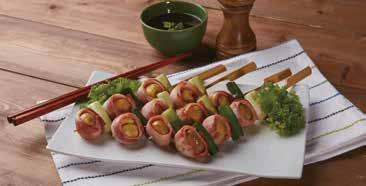
tain 21 mg of vitamin C, Bamtrae’s roasted chestnuts offer more than double that amount at 45 mg. Their potassium content is significantly higher, at 720 mg, compared to 367 mg in imported varieties. Other notable nutritional benefits include a magnesium content of 74.7 mg (versus 64.1 mg in imported chestnuts) and 1.28 mg of iron (compared to 0.9 mg in imported varieties). In short, Bamtrae’s roasted chestnuts are richer in essential minerals such as magnesium, calcium, and iron compared to their imported counterparts.
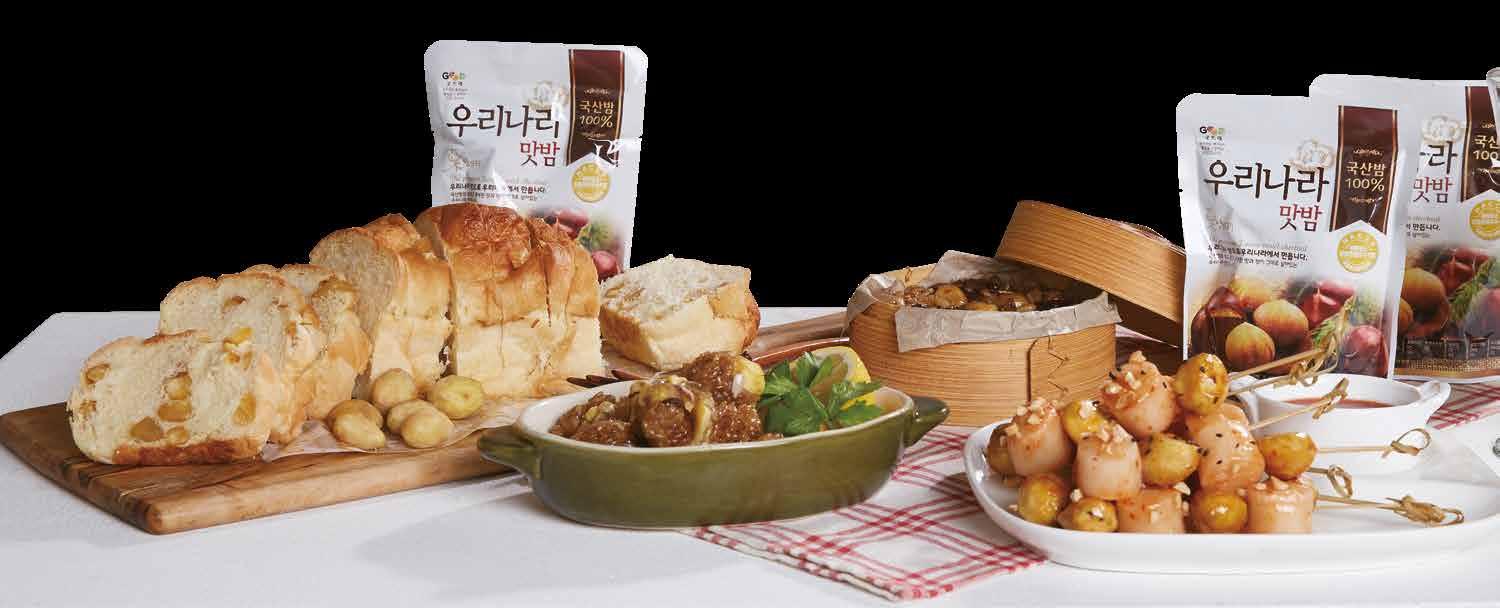
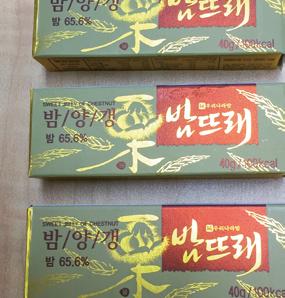
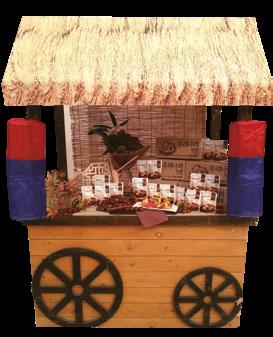



Bamtrae’s Korean roasted chestnuts are made with 100% pure chestnuts. Once peeled, the chestnuts are selected, washed, dried, sterilized, and then packaged. These products are available in a variety of sizes, including 50g, 70g, 80g, 100g, and 500g. Bamtrae’s chestnut jelly is made from 65.6% chestnut, 25.0% water, 8% sugar, and 1.4% agar. The manufacturing process begins with steaming selected raw chestnuts in a steamer. The steamed chestnuts are then peeled and separated using a pressure separator, before being chopped into a paste. The chestnut paste is combined with agar, sugar, and water, then heated in a steam kettle to produce the final product: chestnut jelly. The jelly is available in sizes of 35g, 40g, 45g, and 50g. Bamtrae obtained halal certification in 2015 and registered with the FDA in 2019. In addition to roasted chestnuts and chestnut jelly, Bamtrae produces sweetened chestnuts, chestnut bread, chest-
nut paste, and chestnut husk powder.
Bamtrae’s sweetened chestnuts offer a rich flavor and tender texture, making them an excellent ingredient for use in bread, Japanese wagashi (sweets), and other confectioneries. They can also be mashed to create a nutritious weaning food for infants. Bamtrae’s chestnut bread is a moist and soft loaf made with a chestnut base and filled with chestnut pieces for added texture. Their chestnut cakes feature a blend of chestnut husk, brown rice, and whole wheat, crafted into a round, flat dough with whole chestnuts or chestnut paste added as a filling. Chestnut paste can be used not only in beverages but also as a versatile topping for baked goods. Chestnut latte paste serves a similar function for baking and as a topping. Chestnut husk powder can be used as a dietary supplement or added to yogurt, milk, cereals, salads, and other dishes. It can even be mixed with honey and applied as a skincare product.
Bamtrae农业合作社是韩国国内首家板栗加工制造商, 成功实现了国产板栗加工产品的量产。他们利用火焰式 脱壳机,将原本依赖手工操作的脱壳工艺转变为可以进 行大量脱壳的自动化工艺。这里的所有产品均以扶余产 板栗为原料,先制成最佳品质的熟制板栗仁后,再将其 进行加工,制作羊羹和面包等产品。Bamtrae农业合作 社生产的产品通过了102种农药残留检测,均为安全食 品,不含任何添加剂,完整保留了韩国国产板栗原有的味 道。2022年销售额达到44亿韩元,2023年达到46亿韩元。 2022年,销往中国和美国的出口额约为1万美元。2023
年,销往美国、中国台湾和新加坡的出口额约达8万美元。
Bamtrae熟制板栗仁的糖含量是11.04%,相较于其他公 司使用进口板栗制作的产品(7.74%)接近达到两倍。板 栗中的糖分是一种易于消化的优质双糖,含有增强胃肠 功能的酶。维生素含量是45毫克,比使用进口板栗制作的 产品(21毫克)高出一倍还多。此外,Bamtrae熟制板栗仁
的钾含量是720毫克,进口板栗制品为367毫克;镁含量 为74.7毫克,进口板栗制品为64.1毫克;铁含量是1.28毫 克,进口板栗制品为0.9毫克。因此,镁、钙、铁等矿物质含 量明显高于进口板栗制品。
Bamtrae熟制板栗仁产品由100%的板栗制成。首先,筛 选脱壳的板栗后,经过清洗和干燥工序,再经消毒处理 后进行包装。包装规格有50克、70克、80克、100克和500 克等。板栗羊羹由65.6%的板栗、25.0%的水、8%的糖和 1.4%的寒天制成。板栗羊羹的制作流程为,先将精选的 生板栗放入蒸煮机蒸熟后用压榨机去除外壳,再用切碎 机制成浆状。然后将寒天、糖和水混合溶解后,与浆状的 板栗泥混合放入蒸锅中加热而成。包装规格有35克、40 克、45克和50克等。产品于2015年获得清真认证,并在 2019年完成了FDA注册。除了熟制板栗仁和羊羹之外, 还有糖渍栗子、面包、板栗馅、板栗内皮粉等板栗加工产 品。糖渍栗子的口感比较柔软而且更甜,可用于制作面包 和糕点等,也可以用于婴幼儿的健康辅食。Bamtrae面包
使用板栗制作而成,口感软糯,因加入了很多板栗颗粒, 口感极佳。板栗蛋糕是将加入板栗内皮、糙米和全麦的生 面团烤制成圆形之后,加入板栗或板栗馅制作而成。板栗 馅适合制作饮料或作为面包配料使用,用途广泛。板栗拿 铁馅同样可以用于面包和配料。板栗内皮粉可以添加到 保健品、酸奶、牛奶、米糊、沙拉等各种饮料和食品中食用, 还可以与蜂蜜混合后涂抹在皮肤上,具有美容的功效。

CEO: Kang Shin-hwang
TEL: +82-41-834-7700
E-MAIL: bamtrae@outlook.kr
WEBSITE: www.bamtrae.kr
ADDRESS: 602-27, Chungui-ro, Onsan-myeon, Buyeo-gun, Chungcheongnam-do, Republic of Korea
Bamtrae Farming Association Corporation is a leading Korean company specializing in large-scale chestnut-based processed products using locally sourced, high-quality Buyeo chestnuts. Their offerings include roasted chestnuts, chestnut jelly, and chestnut-based bakery items, all additive-free and rich in essential nutrients. Bamtrae achieved significant sales growth and exports to the U.S., Taiwan, and Singapore, with certifications like halal and FDA registration.
Bamtrae农业合作社农场协会法人是韩国领先的公司, 专注于利用本地优质的扶余栗子进行大规模栗子加工产 品生产。他们的产品包括烤栗子、栗子果冻和栗子烘焙 食品,所有产品均不含添加剂,富含必需的营养成分。農 業合作社取得了显著的销售增长,并出口到美国、台湾和
When considering plant-based meat alternatives for a healthier lifestyle and to combat climate change, many are put off by the perceived lack of taste. In particular, soy-based meat substitutes are often perceived as having an off-putting odor and flavor, deterring potential consumers. These limitations not only impede the growth of the plant-based meat market but also pose challenges for other alternative foods. ALTist Co., Ltd. has developed plant-based foods that closely replicate the taste and texture of real meat and fish, establishing itself as Korea’s leading food tech company in the alternative food sector. In 2023, ALTist reported revenue of KRW 20.8 billion, with projections indicating a 30% increase to KRW 27 billion in 2024. Export sales are also expected to grow, rising from KRW 1 billion in 2023 to an estimated KRW 1.5 billion this year.
ALTist offers a diverse range of plant-based alternatives, encompassing not only meat and seafood but also salt, flour, and sugar substitutes. The company boasts the most extensive portfolio in Korea’s alternative food industry, with over 200 different product lines. ALTist was the first company in Korea to develop a soy-based tuna substitute, which it introduced in triangular kimbap sold at supermarkets and convenience stores. While traditional plant-based tuna products are typically limited to
frozen food, ALTist’s innovation in canned tuna now allows for storage at room temperature. Another notable product is Korea’s first vegan crispy hot dog.
ALTist’s plant-based meats are produced using defatted soybean meal, a byproduct of oil extraction. To achieve a consistency similar to that of traditional meat products, the company blends konjac and mushrooms to enhance the unique viscosity of carbohydrates. Subsequently, amino acids and peptides are incorporated to replicate the aroma and flavor of traditional meat products. ALTist uses a proprietary LMHT (Low-Moisture, High-Temperature) compression technology to align the protein structure. This technology gives their products a texture and mouthfeel that are nearly indistinguishable from real meat. The same technology is also used for their plantbased tuna, delivering the

nuanced texture that differentiates fish from meat. ALTist also operates ALT.a, a Michelin Guide-listed Chinese restaurant in Itaewon, Seoul. The restaurant offers a diverse selection of dishes crafted with ALTist’s plant-based meats and seafood. These include tuna nurungji (scorched rice) canapés, steamed dumplings, doenjang (soybean paste) jjajangmyeon, and kkanpunggi (deep-fried chicken in hot pepper sauce). Popular menu items like plantbased tangsuyuk (sweet and sour pork), yuringi (fried chicken in hot and sour soy sauce), and kkanpunggi are praised for being almost indistinguishable from their meat-based counterparts in both taste and texture. ALT.a’s inclusion in the Michelin Guide highlights ALTist’s success in elevating plantbased ingredients to a global culinary standard. ALTist has obtained a range of quality, hygiene, and safety certifications, including U.S. and Korean vegan certifications, Kazakhstan’s halal certification, European organic certification, and U.S. FDA registration. Since expanding its product range to 45 items in 2019, including its brand “Sultang Daesin Stevia,” Artiste has made significant progress in the plant-based market. The launch of its flagship brand, Gogi Daesin, in 2020 marked the beginning of large-scale distribution through major retailers. In November 2021, ALTist introduced a plant-based tuna product, and the company’s primary product lines now include “Gogi Daesin,” “Sultang Daesin,” “Sogeum Daesin,” and “Milgaru Daesin.”
ALTist products are available at major offline retailers, including E-Mart, Lotte Mart, Homeplus, Shinsegae Department Store, Hyundai Department Store, and E-Land Retail. ALTist has expanded its distribution online through partnerships with leading platforms such as Coupang, Market Kurly, SSG.com, 11st, and social media channels including Instagram, Facebook, and Kakao. ALTist has a global reach, with a presence in the United States, the Netherlands, Germany, France, the Czech Republic, Vietnam, Canada, Indonesia, Taiwan, and Japan. In 2024, the company expanded its export portfolio with the introduction of three types of plant-based frozen kimbap to the United States and stevia-based products to Vietnam.

ミシュランガイドレストランALT.aを 作った㈱Altistの代替食品
気候変動による危機を防ぎ、健康な暮らしのために代 替肉を選択しようとするとき、少なからずためらう理由 は美味しくないからである。豆を使う代替肉独特の生臭 さと味への抵抗感も大きい。このような代替肉の限界 は、他の代替食品の拡大を妨げるハードルでもある。㈱ ALTistは、こうした代替食品の限界を克服し、肉や魚の 本物の味と質感をそのまま再現した、韓国トップの代替 食品専門フードテック企業である。2023年の売上高は 208億ウォンで、2024年にはこれより約30%増加した270 億ウォン余りになると見込まれている。輸出は2023年に は10億ウォン、そして今年は15億ウォンくらいになると予 想される。
㈱ALTistは代替肉と魚類、塩、小麦粉、砂糖に至るまで様 々な分野の代替食品を開発・供給している。約200種の様
々な製品群を有し、代替食品企業のうち最多の製品フォー トポリオと顧客を確保している。韓国で初めて豆を原料と するツナ代替肉の開発に成功し、ツナの代替肉を使っ
た三角おにぎりをスーパーやコンビニで販売してい る。冷凍食品に限られていた「植物性ツナ」を缶詰 の形に作り、常温保管ができるようにした。初のヴ ィーガンホットドッグである植物性クリスピーホット ドッグも、㈱ALTistの製品である。


㈱ALTistは豆(大豆)で代替肉を作る。油を搾りだす脱脂 過程を経た大豆粕を利用する。炭水化物の特徴である 粘度を高めるためにコンニャクとキノコなどを混ぜ、ア ミノ酸とペプチドで肉に近い香りと味を具現する。本物 の肉類に近い噛み心地のために、㈱ALTistで独自開発 したLMHT(Low-Moisture, High-Temperature)圧縮加 工技術でタンパク質組織を作る。水にふやかして破るこ とで、肉類と同じ質感と食感を具現する。植物性ツナも この技術を利用し、肉類とは違う魚ならではの質感が感 じられるようにする。
ソウルイテウォン(梨泰院)にあるALT.a(アルトエイ)は、
㈱Altistが運営する中華料理店である。㈱ALTistの代替 肉と代替魚類を使い、ツナおこげカナッペ、蒸し餃子、 テンジャンジャージャー、カンプンユク(甘酢醤油を使っ た牛肉のから揚げ)などの料理を作る。植物性の肉で作 った酢豚、油淋肉、カンプンユクは、ALT.aを訪れる客 の間で特に人気の高いメニューである。食感と味全ての 面で、本物の肉と見分けが付かないと評価されている。
ALT.aは㈱ALTistが開発したこれらの植物性代替食品を 材料に料理を作り、世界的なレストラン評価基準とされ るミシュランレストランガイドに載るようになった。
㈱ALTistは米国ヴィーガン認証、韓国ヴィーガン認証、カ ザフスタンのハラル、EUオーガニック認証、米国FDAへの 登録など、様々な品質及び衛生・安全に関する認証を獲 得している。2019年に<砂糖の代わりにステビア>など、 独自ブランドのラインナップを45種に拡大した。2020年

には植物性代替肉<肉の代わり>を発売し、大型流通企 業への供給を始めた。そして2021年11月には 植物性ツナを作り発売した。主な製品群として <肉の代わり><砂糖の代わり><塩の代わ り><小麦粉の代わり>などがある。
㈱ALTistの製品はイーマート、ロッテマート、 ホームプラス、新世界百貨店、現代百貨店、 E-LANDリテールなどのオフライン流通チ ャネルに進出している。CoupangやMarket Kurly、SSGドットコム、11番街、Instagram、 Facebook、カカオなど多様なEコマースへの 流通を拡大している。米国、オランダ、ドイツ、 フランス、チェコ、ベトナム、カナダ、インドネ
シア、台湾、日本などに輸出しており、2024年には米国 に植物性冷凍キンパブ3種を、ベトナムに「砂糖の代わり にステビア」を輸出した。

MARKETING DIRECTOR Yoo Jin-sun
TEL: +82-2-6403-3383
E-MAIL: jinsun.yoo@altist.com
WEBSITE: www.altist.com
ADDRESS: 8F, 17, Seonyu-seoro, Yeongdeungpo-gu, Seoul, Republic of Korea
ALTist Co., Ltd. is Korea’s leading food tech company specializing in plant-based meat, seafood, and alternative food products, known for their realistic taste and texture. They utilize innovative LMHT technology and a wide range of ingredients to closely replicate real meat and fish.
ALTist Co., Ltd.は、植物性の代替肉やシーフード、その他の代替 食品を専門とする韓国のトップフードテック企業であり、リアルな 味と食感で知られています。革新的なLMHT技術と多様な原料を 活用し、実際の肉や魚に近い食感と風味を再現しています。
Chammifood Co., Ltd. produces and sells instant dehydrated food products from do mestic dried and cooked rice. Their flagship product line, the Hot & Cook series, features self-heating lunchboxes that are not only safe and compact but also highly convenient for outdoor activities. The lightweight design, which uses dehydrated rice, has contributed to the success of the Hot & Cook series in both domestic and international markets. Since launching three varieties of Hot & Cook self-heating meals, Chammi food has seen a 300% increase in sales over the past four years. The company was initially established as “Chammi” in 2004 and began developing instant dehydrated bibimbap. In 2005, the company launched its first three products—Beef, Kimchi, and Mushroom Bibimbap—under the Baro Bibimbap brand. By 2009, they had introduced Baro Japchae Rice, and in 2010, they launched Baro Bibimbap, followed by OEM production of instant bibimbap. In 2011, Chammifood commenced exports to Japan, launching three new export varieties: Beef, Kimchi, and Mushroom Bibimbap. Since 2012, the company has expanded its export operations to include Australia and the United States, followed by Russia, Singapore, Hong Kong, and Mongolia in 2014. Following its official incorporation as Chammifood Co., Ltd. in 2012, the company commenced
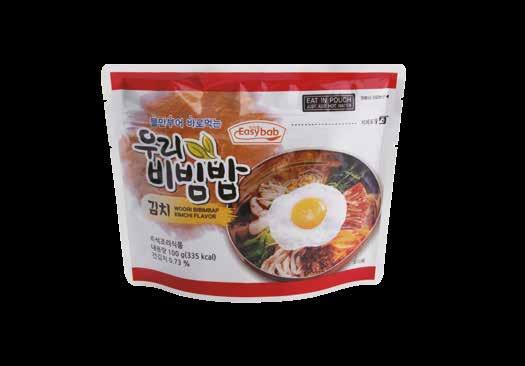


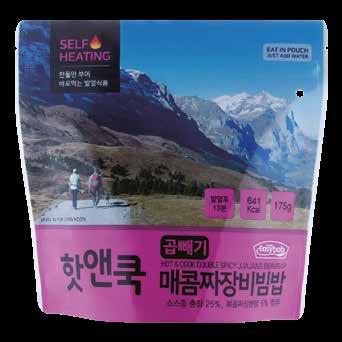

the provision of in-flight meals to Eastar Jet in 2012, Jeju Air in 2014, and T’way Air in 2017. In 2015, Chammifood obtained HACCP certification and commenced supplying combat rations to the Korean Army and exporting to the Philippines. In 2018, they registered with the U.S. FDA and initiated exporting to Taiwan.
The Hot & Cook self-heating meal series offers four varieties of bibimbap: Beef, Spicy Pork, Kimchi, and Spicy Jjajang. Four “double serving” options are also available: Double Beef, Double Spicy Pork, Double Kimchi, and Double Spicy Jjajang. The product line also features four Hot & Cook noodle and rice options: Spicy Seafood Ramyeon, Kimchi Stew Ramyeon, Beef and Seaweed Soup Ramyeon, and Nagasaki Jjamppong Ramyeon. Additionally, the company offers two “Ready-to-Eat” bibimbaps: Beef and Spicy Pork. These meals are ideal for consumption at high altitudes, as they only require cold water and are ready to eat within 10 minutes. Chammifood’s Woori Bibimbap line comprises five distinct varieties: Beef, Kimchi, Spicy Jjajang, Mushroom, and Spicy Pork. The Baro Bibimbap with Soybean Paste Soup line offers Beef, Mushroom, and Kimchi options.The Emergency Food line features Beef, Spicy Pork, and Spicy Jjajang. Additional products, such as the Hot Chicken Flavor Bibimbap and Hot Chicken Flavor Noodle and Rice, are also available. For customers seeking a quick and convenient meal combining ramen and rice, the Noodle and Rice series offers Jjamppong, Nagasaki Jjamppong, Kimchi Stew, and Beef and Seaweed Soup—all prepared by simply adding hot water. Chammifood has experienced sustained growth in total sales over the past five years. In 2019, sales reached KRW 1.4 billion, followed by KRW 2 billion in 2020, KRW 2.8 billion in 2021, KRW 4.3 billion in 2022, and KRW 5.6 billion in 2023.The following is a breakdown of export revenue for the same period: USD 102,000 in 2019 (including USD 79,000 to Hong Kong, USD 12,000 to Singapore, and USD 11,000 to the Netherlands); USD 124,000 in 2020 (including USD 92,000 to Hong Kong, USD 16,000 to Singapore, and USD 16,000 to the Netherlands); USD 105,000 in 2021 (including USD 62,000 to Hong Kong, USD 14,000 to the Netherlands, and USD 29,000 to Japan); USD 73,000 in 2022 (including USD 45,000 to Hong Kong and USD 28,000 to Japan); and USD 69,000 in 2023 (including USD 34,000 to Hong Kong, USD 7,000 to Singapore, USD 13,000 to Brazil, and USD 15,000 to the Netherlands).

(株)Chammifood自热盒饭畅销
海外
(株)Chammifood使用韩国产脱水大米和脱水米饭生产 销售速食脱水食品。该公司的主打产品是“Hot&Cook” 自热盒饭系列产品。这是一种利用稳定的发热体和小包 装制成的fo推出了牛肉、辛奇和蘑菇三种口味的Chammi BARO拌饭产品。2009年又推出了BARO什锦炒粉丝饭,并 于2010年正式开始速食拌饭产品的代工生产。 2011年开始向日本出口,并推出了牛肉、辛奇、蘑菇三种 口味的出口专用WOORI拌饭产品。2012年开始向澳大利 亚和美国出口,2014年开始销往俄罗斯、新加坡、中国香 港和蒙古国。2012年变更为法人公司(株)Chammifood 后向易斯达航空供应机内餐,之后2014年向济州航空、
2017年向德威航空供应机内餐食品。公司于2015年获得 了HACCP认证并向韩国陆军供应战斗口粮,同年开始出 口到菲律宾。在2018年完成美国FDA设施注册后开始向 中国台湾地区出口。
(株)Chammifood的自热盒饭“Hot&Cook”系列包括牛 肉、辣炒猪肉、辛奇、香辣炸酱四种口味的“Hot&Cook 拌饭”,以及双倍牛肉、双倍辣炒猪肉、双倍辛奇、双倍香 辣炸酱四种口味的“Hot&Cook双倍拌饭”。此外,还有
“Hot&Cook拉面爱饭”产品,包括炒码面、辛奇汤、牛肉 海带汤、长崎炒码面四种口味,以及牛肉和辣炒猪肉口味 的“速食拌饭”,这些产品均为可以在山顶享用的自热食品。
只需加入冷水后等待10分钟即可享用热腾腾的美食了。
(株)Chammifood的方便食品“WOORI拌饭”有牛肉、辛 奇、香辣炸酱、蘑菇、辣炒猪肉五种口味;“酱汤BARO拌


饭”有牛肉、蘑菇、辛奇三种口味;“进击的应急食品”有牛 肉、辣炒猪肉、香辣炸酱三种口味。“火鸡拌饭”和“火鸡拌 面爱米饭”都是可以加入热水后即食的食品。可以同时享 用方便面和米饭的方便食品“拉面爱饭”有炒码面、长崎 炒码面、辛奇汤、牛肉海带汤四种口味,同样加热水冲泡 后即可食用。
(株)Chammifood最近五年的销售额分别是,2019年14 亿韩元,2020年20亿韩元,2021年28亿韩元,2022年43 亿韩元,2023年56亿韩元。其中出口额为,2019年,中国 香港7.9万美元、新加坡1.2万美元、荷兰1.1万美元,总计 10.2万美元;2020年,中国香港9.2万美元、新加坡1.6万 美元、荷兰1.6万美元,总计12.4万美元;2021年,中国香 港6.2万美元、荷兰1.4万美元、日本2.9万美元,总计10.5 万美元;2022年,中国香港4.5万美元,日本2.8万美元,总 计7.3万美元;2023年,中国香港3.4万美元、新加坡7千美 元,巴西1.3万美元、荷兰1.5万美元,总计6.9万美元。



Chammifood Co., Ltd. specializes in instant dehydrated food products, notably the Hot & Cook self-heating meal series, which has seen significant sales growth domestically and internationally. Since its founding in 2004, the company has expanded its offerings to include bibimbap, noodles, and inflight meals, exporting to various global markets.
(株)Chammifood专注于即食脱水食品,特别是Hot&Cook自热
CEO: Kim Jung-hoon
TEL: +82-70-7636-3011
E-MAIL: barobbb@hanmail.net, barobbb@gmail.com
WEBSITE: www.barobbb.co.kr
ADDRESS: 772-6, Seongsan-o, Seongsan-myeon, Goryeong-gun, Gyeongsangbuk-do, Republic of Korea

Cheese is made primarily from the fermentation of dairy products such as cow’s milk, sheep’s milk, or goat’s milk. It has been a popular food for thousands of years and is available in a wide variety of flavors and types worldwide. The Minis try of Food and Drug Safety Standards Codex de fines cheese as a product made by coagulating, heating, and concentrating milk or dairy products with the addition of lactic acid bacteria, rennet (a protein-hydrolyzing enzyme that solidifies milk), organic acids, and other ingredients. There are two main categories of cheese: natural cheese, which is made by adding minimal ingredients like lactic acid bacteria and organic acids to milk and allowing it to age and ferment without heating, and processed cheese, which is made by adding other ingredients and materials to natural cheese. In the 1960s, Imsil Cheese made history by becoming the first company in Korea to successfully produce cheese, launching the country’s cheese market. Since that time, a variety of cheeses have been imported and introduced to consumers. As Korean consumers’ tastes have become more Westernized and health-conscious trends have gained traction, cheese consumption has expand-



ed, leading to an increase in domestic cheese processing companies. In 2022, the domestic cheese production value reached KRW 759.2 billion, reflecting a 13.1% increase from the previous year. The cheese market is undergoing a transformation to align with evolving consumer preferences. In addition to traditional processed sliced cheese, premium cheeses such as fresh mozzarella, grilling cheese, ricotta, cream cheese, and string cheese are being introduced and are gaining popularity. Notable domestic cheese products include Imsil Cheese’s “Grilling Cheese” and “Smoked Cheese,” Yonsei Milk’s “100% Natural String Cheese,” and Sangha Cheese’s fresh ricotta made from domestic milk. Recently, small-scale premium cheeses produced at local farms have also entered the market, such as “Mascarpone Cheese” from Youngjun Farm and “Organic Fresh Mozzarella” from Jeju St. Isidore Farm.
In light of these trends, the Korean cheese market is poised to become more diverse and premium-focused, seamlessly integrating into the broader landscape of Korean cuisine. The growing trend of incorporating cheese into a variety of dishes suggests that the popularity of cheese in Korea will continue to grow steadily.








チーズは主に牛乳や羊乳、ヤギ乳などの乳製品を発酵させ て作った食品である。数千年前から人類が楽しんできたチー ズは、全世界に多様な種類と味が存在する。食品医薬品安 全処食品公典では、原乳または乳加工品に乳酸菌、レンネッ ト(牛乳を固めるタンパク質加水分解酵素の一種)、有機酸 などを加え、凝固、加熱、濃縮などの工程を経て製造・加工 したものをチーズと定義している。製造方法で分類すると、 原乳に乳酸菌、有機酸など最小限の原料だけを入れ加熱せ ずそのまま熟成・発酵させたナチュラルチーズと、ナチュラル チーズにその他の添加物や副材料を入れて作ったプロセス チーズに分けられる。
韓国チーズ市場の歴史は、1960年代に「イムシル(任実)チー ズ」で韓国初のチーズ生産に成功したことから始まり、その 後様々なチーズが輸入され消費者に紹介された。その後、 消費者が欧米風の味を好むようになり健康志向トレンドが チーズ消費にまで拡大し、韓国にもチーズを加工する業者 が増えた。2022年の韓国のチーズ生産額は7,592億ウォン で、対前年比13.1%増加している。
消費者の好みによってチーズのトレンドも変化しており、従 来のスライスプロセスチーズの他に、最近は生モッツァレラ、 焼いて食べるチーズ、リコッタチーズ、クリームチーズ、ストリ ングチーズなど高級チーズが発売され消費者のニーズを満 たしている。韓国の代表的なチーズ企業と製品としては、イ ムシルチーズの「焼いて食べるチーズ」「スモークチーズ」な どのほか、ヨンセ(延世)牛乳の「ナチュラルチーズ100%スト リングチーズ」、サンハチーズが韓国産牛乳で作る新鮮な「リ コッタチーズ」などがある。また、最近はヨンジュン牧場の「 マスカルポーネチーズ」、チェジュ(済州)聖イシドル牧場の「 オーガニックフレッシュモッツァレラ」など、プレミアムチーズ を生産・販売する小規模の農場もある。
こうしたトレンドを背景に韓国のチーズ市場はより多様化・ プレミアム化すると見込まれており、色んな韓国の料理とチ ーズを一緒に食べる文化が広がり、チーズの人気は益々高 まることが予想される。

The export value of Korean frozen dumplings reached an impressive KRW 88.5 billion last year, reflecting a continued rise in popularity of these products. Having established itself as a key K-food product alongside ramyeon and snacks, the frozen dumpling market has nearly doubled in growth over the past five years. The United States remains the largest export market, with Japan ranking second. Notably, Japan, with a total import value of USD 1,569 for frozen dumplings, shows significant potential for continued growth.
Japan’s geographical proximity to Korea is an advantage for the distribution of frozen dumplings, while the Japanese fondness for “gyoza” has contributed to the success of Korean dumplings in this market. The growing interest in K-pop and Korean cuisine has also fueled enthusiasm for Korean-style dumplings. Furthermore, the shift in eating habits due to the impact of COVID-19, which has led to a preference for convenient and easy-to-prepare foods, has further boosted the popularity of frozen dumplings. Although both Korean dumplings and Japanese gyoza have their roots in China, there are notable differences between the two, including variations in dough fermentation, size, fillings, and cooking methods.
A variety of Korean frozen dumpling products are available on Japan’s leading online shopping platform, Rakuten. Notable products include CJ Foods’ “Bibigo King Mandu,” Chungjungone’s “Japchae Mandu,” and Dongwon’s “Gaeseong King Mandu,” along with offerings from other brands. The Rakuten selection includes a variety of classic meat flavors, kimchi, shrimp, seafood, and unique options such as kimchi cheese. In addition, there is a diverse range of dump -



lings available, including pan-fried, boiled, handmade, and thin-skinned varieties, which have proven to be highly sought-after by Japanese consumers.
Customer feedback for the frozen dumplings on Rakuten has been positive: “The dumpling skin is chewy and delicious, so I repurchased it,” “It’s easy to cook and pairs well with Korean soy sauce, making it very tasty,” and “Larger than typical dumplings, they’re great as a side dish, and I always keep some in the freezer.”
韩国速冻饺子成为日本乐天市场的热 销商品
韩国速冻饺子人气持续攀升,去年其出口额上涨至885亿韩 元。作为继拉面和零食之后的K-Food核心产品,速冻饺子 在过去五年内实现了近两倍增长。美国成为其最大出口市 场,而日本位居第二。去年,韩国对日本的冷冻饺子出口额 高达1569美元,展现出强劲的增长潜力。
韩日两国地理位置相邻,速冻饺子产品的供应更为便捷,而 日本饮食文化中对饺子的偏爱,也为韩国速冻饺子成功进军 日本市场奠定了基础。此外,随着k-pop和韩国食品人气的 持续攀升,韩式饺子逐渐受到日本消费者的青睐。新冠疫情 过后,饮食文化发生了改变,食用方便的速冻饺子因而更加 走俏。尽管两国的饺子同源于中国,但在饺子皮的发酵、大 小、馅料和烹饪方法等方面,仍存在诸多差异。
日本知名线上购物平台乐天市场上,出售多款韩国速冻饺 子产品。主要包括CJ Food“必品阁王饺子肉菜馅(Bibigo King Mandu)”、清净园“什锦炒粉丝饺子”、东远“开城王饺 子”等。线上商城出售的速冻饺子有肉馅、辛奇馅、虾仁馅、 海鲜馅以及辛奇奶酪馅等各种口味,还有煎饺、水饺、手工饺 子和薄皮饺子等多种类型可供选择,深受日本消费者的喜爱。 在乐天市场购买速冻饺子的消费者纷纷留下好评:“饺子皮 筋道,很好吃,所以又买了”,“煎起来简单,蘸韩国酱油吃,非 常好吃”,“比普通饺子个头大,作为配菜也很好吃,家里的冰
The Korea Agro-Fisheries & Food Trade Corporation (aT) Paris Office showcased Korean agricultural products at an international multi-sport event, with the objective of raising awareness of Korean food culture. aT leveraged the global attention that the Olympics attract by partnering with the Korea Tourism Organization’s Paris office for the “2024 Paris K-Tourism Roadshow” and with the Ministry of Culture, Sports, and Tourism for the “Korea House Promotion Project” to highlight K-FOOD.
The 2024 Paris K-Tourism Roadshow was held over two days at Forum des Halles, the largest shopping mall in central Paris. The event targeted local Millennials and Generation Z, with an age range of teens to thirties. A promotional booth was established, offering visitors the opportunity to experience Korean tourism, culture, and cuisine. The booth, themed “A Journey to Korea,” showcased a range of products readily available in Paris, including beverages, snacks, ramen, tteokbokki, kimchi, yuzu tea, and traditional liquor.


Over the course of the two-day event, the booth provided samples of a variety of Korean foods, with approximately 10,000 servings prepared to attract visitors’ attention. Furthermore, a cocktail demonstration featuring traditional Korean liquor and beverages was held twice daily, with each session lasting 30 minutes. The event received positive feedback from visitors. Additionally, a K-food sales map was produced and distributed at the event, providing information on where to purchase Korean food during the Olympic Games.
The Korea House Promotion Project was held over five days at a convention center conveniently located just 15 minutes on foot from the Eiffel Tower in central Paris. This project was part of a broader initiative to promote K-content — including music, food,
film, and fashion — to global visitors attending the Olympics in Paris. As part of the promotional campaign, K-FOOD goody bags containing products from the official sponsors of the Korean Sports Association were distributed. Maps of Korean food outlets in Paris encouraged locals to find and purchase Korean agricultural products. The event was further promoted online through the social media channels of the Paris office and the Korea Tourism Organization. In addition, promotional activities were organized within the athletes’ village, featuring products such as kimchi, ramen, and ice cream to further elevate the image of Korean food during the Olympic Games.
Project Name
Promoting Korean Agricultural Products in Conjunction with the Paris 2024 Summer Olympics
Duration June 22-23, 2024 / July 27-31, 2024
Location
Westfield Forum des Halles, Paris (Shopping Mall) / Korea House (7th arrondissement, Paris)
Promotional items Snacks, Beverages, Ice Cream, Kimchi, Traditional Liquor, Yuja Tea, Omija Syrup, Heat-Processed Poultry




Korea’s fruit wholesale markets provide a dynamic overview of the country’s fresh produce offerings. These markets play a crucial role in facilitating the connection between producers and consumers, enabling farmers to sell their harvests while offering customers fresh fruits at competitive prices. The markets are most active in the early morning hours, when producers and distributors from all over the country gather to trade fruit through auctions. Some of Korea’s most prominent wholesale markets include Garak Market in Songpa-gu, Seoul, the largest of its kind in the country; Gangseo Market in Gangseo-gu, Seoul; and Guri Market in Guri, Gyeonggi Province. Korea’s fruit wholesale markets serve as essential hubs that benefit both producers and consumers alike.



Kimchijeongol is a traditional Korean dish that combines kimchi with a variety of other ingredients to create a rich and flavorful stew. The history of Kimchijeongol is closely linked to that of Korea. Kimchi has been a staple since the Three Kingdoms period, undergoing various forms of evolution. By the late Joseon Dynasty, the use of red pepper powder had become widespread, leading to the modern version of kimchi. Kimchijeongol, which uses this iconic kimchi, has long been a favorite among Koreans. The dish harmonizes the deep, savory flavors of kimchi with an array of ingredients, creating a delicious and nutritious meal. Kimchi is also rich in vitamins A, B, C, and E and various minerals, which help boost the immune system.


Adding ingredients like ramyeon, mushrooms, dumplings, or cheese to Kimchijeongol makes it even more delicious!
Ingredients
450 g Korean cabbage kimchi
100 g pork
Half a block of bean curd
Half an onion
150 g rice cakes (tteokguk tteok)
1.5 L water
Green onion
Sauce
1 Tbsp gochujang (red chili paste)
2 Tbsp gochugaru (red chili flakes)
1 Tbsp soy sauce
1 Tbsp minced garlic
1 Tbsp sugar
1/2 Tbsp sesame oil
Instructions
1. Mix all the sauce ingredients together to make a spicy seasoning paste.
2. Cut the pork into bite-sized pieces, then take 1 tablespoon of the prepared seasoning paste and mix it with the pork.
3. Cut the Korean cabbage kimchi and bean curd into bite-sized pieces. Thinly slice the onion and green onion.
4. Rinse the rice cakes (tteokguk tteok) and set aside to drain.
5. In a hot pot, add a little cooking oil and stir-fry the seasoned pork over medium heat. Once the pork is cooked, add the kimchi and stir-fry for another 5 minutes.
6. Place the prepared vegetables and rice cakes in the pot, add the remaining seasoning paste, and pour in the water. Bring to a boil and continue cooking until the pork is cooked through.



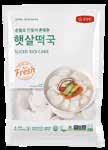





Simplicio Fernandez fernandezsimplicio@gmail.com
The rise of K-Wine in February 2023 vol.328 issue caught my attention most because I am fond of wines especially those are made organically which are good for our health. Interesting to know that Korean wines are mostly made from fruits. Famous wineries were introduced along with its best wines. Korean wines are now increasingly known overseas. Cheers to Sudosan Winery for its finest wine made from 100% wild grapes. That’s a great achievement for Korea. would like to have that wine and taste it one day. Korea’s wine exports have boosted the Korean economy and promoted the country’s K-wine industry.
Hurum Maqshuro hurummaqshuro@gmail.com
Every month almost always read the Agrafood magazine that I subscribe to through my email. I would like to learn more about Korean food. I also have an opinion about sharing the Korean halal recipe. As we know, so many people around the world love Korean food, but there are also Muslim people who want to eat or recreate Korean food with halal ingredients. I hope Agrafood will also consider this. I am sure the response will be great!
Natashia Marinay natashiamarinay@gmail.com
My favorite so far for this 2024 release of Agrafood Magazines is April. I’m transitioning to a no-sugar or low-sugar diet for my health. The April issue is really helpful in finding the right foods and snacks to eat when you’re on a low-sugar diet. My current favorite of the items mentioned is the zero-sugar chocolate balls. It’s really amazing that even though it has no sugar, it tastes like chocolate. The design is aesthetically perfect for me. I will continue reading Agrafood Magazine throughout the year. Thank you for producing such a great magazine.

Qingdao Branch Office
Room 705, Yuanxiongguojiguangchang
Beijing Branch Office 603 Room, Block A, Fairmont Tower No.33 Guangshun North Street, Chaoyang District, Beijing, 100102, China
(100102 中國 北京市 朝阳區 广顺北大街
33号院 1号楼 1单元 6层 603室)
E-Mail: beijingat@at.or.kr
TEL: 86-10-6410-6120~1
070-4617-5090~1, 7377
FAX: 86-10-6410-6122
Shanghai Branch Office Room 3201, New Hongqiao Central Plaza No.83, LouShanGuan Rd., Changning District, Shanghai, 200336, China
(200336 中國 上海市 長寧區 婁山關路 83 號 新虹橋中心大厦 3201室)
E-Mail: shanghaiat@at.or.kr
TEL: 86-21-3256-6325
070-7077-6197, 6199, 6205 FAX: 86-21-3256-6328
Dalian Branch Office
Building, No.26, Hongkong Middle Road, Qingdao, 266071, China (中國 山東省 靑島市 市南區 香港中路 26 号 远雄国际广场 705户)
E-Mail: qingdao@at.or.kr
TEL: 86-532-5566-8870~3, 5 FAX: 86-532-5566-8873
Qingdao aT logistics Co., Ltd
266108, Qingdao aT logistics Co., Ltd
3 Baishawan Rd., Liuting Street, Chengyang, Qingdao, China (青岛市 城阳区 流亭街道 白沙湾路3号
青岛爱特物流有限公司)
E-Mail: qingdao_logistics@at.or.kr
TEL: 86-532-6696-2229
070-7938-0863~4
FAX: 86-532-6696-2181
Ha Noi Branch Office
#1213, 12th floor., Keangnam Hanoi Landmark 72 Tower, Plot E6, Pham Hung Str., South Tu Liem Dist., Ha Noi., Viet Nam
E-Mail: hanoi@at.or.kr TEL: 84-24-6282-2987
070-4617-7101~2, 7256~7258 FAX: 84-4-6282-2989
Jakarta Branch Office
The Energy Building 20th FL, Zone F, SCBD Lot.11A
JL.Jenderal Sudirman Kav 52-53, Jakarta 12190 Indonesia
E-Mail: jakarta@at.or.kr
TEL: 62-21-2995-9032~3, 9035, 9094
070-4617-2695
FAX: 62-21-2995-9034
Kuala Lumpur Branch Office
Suite 6-04, 6th Floor, Menara Hap Seng, Jalan P. Ramlee, 50250 Kuala Lumpur
E-Mail: atcenterkl@at.or.kr
TEL: 60-3-2706-4299
070-5223-4901, 070-4617-7238 FAX: 60-3-2706-4301
Singapore Branch Office
1 Wallich Street #14-01 Guoco Tower, Singapore 078881 TEL: 65-9855-8277
Tokyo Branch Office
Korea Agro-Trade Center, Tokyo Korea Center 5F, 4-4-10 Yotsuya, Shinjuku-ku, Tokyo, 160-0004, Japan
(東京都新宿区四谷4-4-10 KOREA CENTER5F)
New York Branch Office
15 East 40th Street Suite 701 New york NY 10016, USA
E-Mail: newyork@at.or.kr
TEL: 1-212-889-2561
FAX: 1-212-889-2560
Los Angeles Branch Office
12750 Center Court Drive South, #255, Cerritos, CA 90703, USA
E-Mail: losangeles@at.or.kr TEL: 1-562-809-8810
FAX: 1-562-809-1191
São Paulo Branch Office
Av Paulista 1636, 10andar, #1008 –
São Paulo CEP 01310-000
E-Mail: saopaulo@at.or.kr TEL: 55-11-3283-0089, 55-11-3286-0059
Arman Carinan armancarinan@gmail.com
I love how the photos and design of the magazine as a whole are very bright that can catch the attention of its readers. I would love to see an issue that has a monthly theme like a certain region in Korea and discusses its food. That would be very interesting to read.
Nazih Mohammed naz1982ih@gmail.com
Agrafood Magazine has opened my eyes to the fascinating world of food production! The magazine provides clear and informative articles about where food comes from and the challenges in the agricultural industry. The beautiful photographs show the hard work and dedication of farmers around the world. Agrafood makes learning about food both educational and fun.
Ola abd elmoniem olaabdelmoniem7@gmail.com
I really loved the magazine so much, it not only contains a lot of useful information, also spotlights on Korean culture and food traditions I am studying food nutrition and this magazine helped me a lot, knew things for the first time also the excitement while reading it is impossible to feel bored while reading thank you for your hard work hope all the best for you.
Room 1302, Xiwang Building,NO136 Zhongshan Road,Zhongshan District,Dalian 116001
(大连市中山区中山路136号希望大厦 1302号)
E-Mail: dalianat@at.or.kr TEL: 86-411-3960-3361~3 070-4617-3278
FAX: 86-411-3960-3362
Hongkong Branch Office Room 1003, 10F Jubilee Centre, 18 Fenwick Street, 46 Gloucester Rd, Wanchai, Hong Kong
E-Mail: hkatcenter@at.or.kr
TEL: 852-2588-1614~6 070-4617-2696, 7116 FAX: 852-2588-1919
Ho Chi Minh Branch Office
CJ Building, Floor 3, 2 Bis 4-6 Le Thanh Ton Street Ben Nghe Ward, District 1, Ho Chi Minh City
E-Mail: atcenterhcmc@at.or.kr
TEL: 84-28-3822-7504
070-4617-3276, 070-8098-6514 FAX: 02-838-227-503
Bangkok Branch Office
#2102 Level 21, Interchange 21, 399 Sukhumvit Road, North Klongtoey, Wattana, Bangkok 10110 Thailand
E-Mail: bangkok@at.or.kr
TEL: 66-2-611-2627
070-4617-7226~7
FAX: 66-2611-2626
E-Mail: tokyo@at.or.kr TEL: 81-3-5367-6656 070-4617-7061~2, 070-8287-3060 FAX: 81-3-5367-6657
Osaka Branch Office
8F, Nomura Fudousan Osaka Bldg. 1-8-15, Azuchimachi, Chuou-Ku, Osaka, 541-0052, Japan
(大阪市 中央區 安土町 1-8-15, 野村不動 産大阪B/D 8F)
E-Mail: osaka@at.or.kr TEL: 81-6-6260-7661 070-7000-4138 FAX: 81-6-6260-7663
Dubai Branch Office 57528 Office #48, Sunset Mall, Jumeirah Beach Rd, Jumeira 3, Dubai, UAE
E-Mail: dubai@at.or.kr TEL: 971-4-339-2213 FAX: 971-4-456-1155
Paris Branch Office
Korea Agro-Trade Center, 89 Rue du Gouverneur Général Eboué (1er etage), 92130, Issy-les-moulineaux, France
E-Mail: paris@at.or.kr
TEL: 33-1-4108-6076~8, 6095~6 FAX: 33-1-4108-2016
Moscow Branch Office 123610, Moscow, Krasnopresnenskaya naberezhnaya 12, 6th floor, 608 office
E-Mail: atmoscow@at.or.kr TEL: 7-924-007-1528 070-4617-3277
